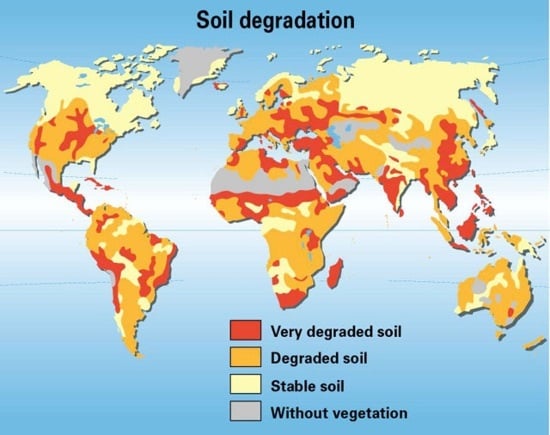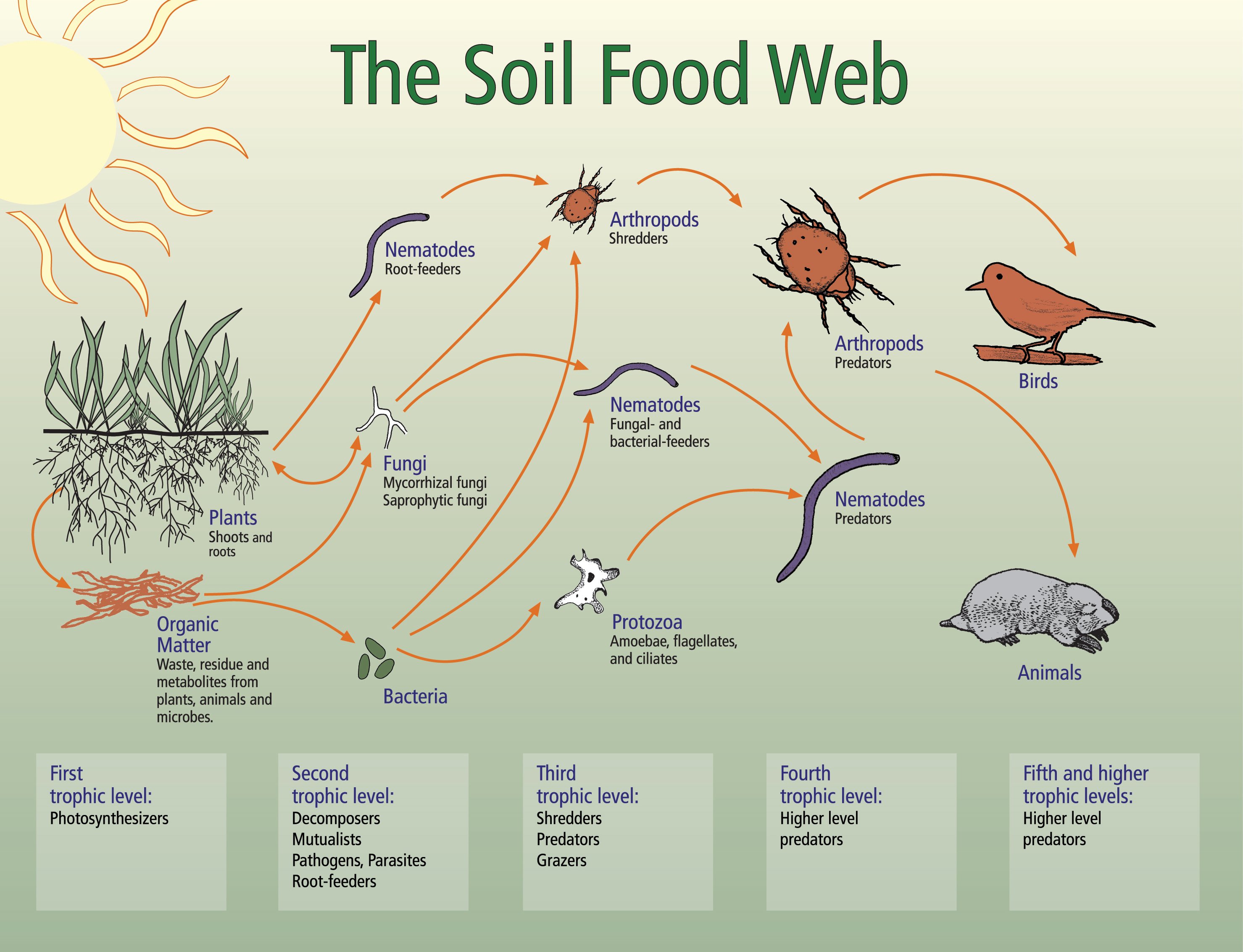.png?width=1024&name=WWW.hOLGANIX.COM%20(12).png)
Soil health has become an important benchmark for all growers - regardless of whether you are growing corn, berries, turfgrass, or ornamental trees and shrubs. Yet for many, soil health definitions and terms are new and confusing! In this blog, we focus on providing simple and concise explanations for 10 key soil health terms.
To “short-cut” the article, you can select any term you would like to explore using the list below.
Soil Structure
Soil structure influences water and air movement, soil microbe activity, root growth, and seedling emergence. In short, it is the arrangement of pore spaces and solid soil particles that are glued together by sticky substances created by bacteria and root hairs. Good soil structure has 50% soil particles and 50% pore spaces occupied by air and water.
Soil Degradation
Soil degradation is the decline in soil quality; specifically, it is the decline of the soil’s physical, biological and chemical state. Depending on the severity of degradation, the soil can still be used for crop production. According to the USDA, the “productivity of some lands has declined by 50% due to soil erosion and desertification.”

The Intergovernmental Science-Policy found that 75% of our lands are degraded. Their assessment took three years and included more than 100 experts from 45 countries. Check out the image above from GRID Arendal (A center collaborating with the United Nations Environment Program) which demonstrates degraded land worldwide.
Soil degradation can be caused by improper land use through agriculture, pasture urban or industrial purposes.
>>Looking to learn more about Soil Degradation? Check out the U.N. to combat desertification
The Soil Food Web
Within the natural world there exists a complex balance among living organisms known as the “food web.” Plants, animals, and microorganisms are all instruments in an orchestra; each plays a crucial part in the natural symphony of life. If even one of the players is out of tune, the whole soil food web suffers. However, when everything is in order, the results are beautiful.
A healthy soil food web is very similar to the food web we all learned in middle school (see image below from the National Resources Conservation Services).

One of the functions of a healthy soil food web is to hold nutrients in non-leachable forms so they remain in the soil until the plant requires them. The plant triggers the right soil microbes to convert nutrients into forms the plant can uptake (but which are typically very leachable), in exchange the plant provides sugars for the microbes. When the correct ratio of fungi and bacteria to protozoa (prey to predator) is present, the soil pH, structure and nutrient cycling occur at optimum rates, producing the right form of nutrients for the plant when the plant needs them.
>>Watch our 3.5-minute video on the soil food web to learn more
Soil Microbes
Soil microbes recharge soils, which ultimately leads to improved yield, root growth, and crop resilience against stress. Increasing beneficial microbe populations and diversity in the soil is an important component of improving soil health. In fact, it is impossible to build topsoil, and soil structure and convert plant and animal debris into nutrients without microbes.
There are 5 types of soil microbes: bacteria, actinomycetes, fungi, protozoa, and nematodes. Each type conducts a unique job to improve soil and plant health.
Growers and turf professionals can increase their soil microbe populations and diversity by:
1. Applying a microbial product like Holganix Bio 800+ Agriculture - Holganix Bio 800+ Agriculture harnesses the power of over 800 species of beneficial soil microbes that improve: (1) soil health, (2) plant resilience against stress like disease and traffic, (3) crop yields, (4) root depth and density, and (5) turf professionals can reduce their use of fertilizers and pesticides.
2. Supporting microbes already present in the soil with microbe food - Applying sugars, using compost, reducing your tillage, and incorporating cover crops are all ways to feed the microbes already present in your soil or those you apply to your soil through microbial products. However, deep freezes, flooding, tillage, and some chemicals can harm the soil’s microbiome, so it’s not just important to support the microbes already present in the soil but to also supply a diverse concentration of microbial species.
>>Check out this 4.5-minute video on the top 5 most interesting soil microbes
Beneficial Soil Bacteria
The Food and Agriculture Organization (FAO), states, “bacteria may well be the most valuable of life forms in the soil.” Beneficial soil microbes are the crucial workforce of soils and are charged with breaking down nutrients and releasing them to the root zone of the plant. Some species like Plant Growth Promoting Rhizobacteria, release plant hormones that encourage plant growth.
>>Check out this 5-minute read on Plant Growth-Promoting Rhizobacteria
Beneficial Soil Fungi
Like bacteria, fungi also live in the root zone and help make nutrients available to plants. For example, Mycorrhizae fungi facilitate water and nutrient uptake by the roots and plants to provide sugars, amino acids, and other nutrients. Other beneficial soil fungi like Trichoderma help the plant fight disease and improve root growth.
>>Check out this technical article on the benefits of Mycorrhizae
Cation Exchange Capacity
Think of the soil as the pantry for plants, storing the necessary nutrients to feed the plant and ultimately boosting plant health. The Cation Exchange Capacity (CEC) is the soil’s ability to maintain and release nutrients to the plant. So, the higher the CEC, the larger the pantry and the more “food” the soil has the ability to store and feed to the plant.
How can you increase CEC? Check out this blog on how superintendents like Shannon Easter at Broken Sound Golf Club and Matt Boyd at Orchid Island Golf and Country Club, are using HGX PRO Bio 800+ Golf to drive CEC.
>>Read our case studies on improving CEC
Soil Organic Matter
Soil organic matter (SOM) is made from carbon and once-living plants that are broken down by soil organisms like bacteria, fungi, and earthworms. Soil organisms utilize SOM as food, and when digested, exude nutrients and humus. Once SOM has been efficiently broken down, SOM becomes humus.
Increased SOM in the soil promotes improved soil structure, biological activity, and an increased ability to hold and release nutrients and water in the soil. Good, healthy soil contains 3 to 5% SOM. Low SOM is a sign of soil degradation.
So, how can you increase SOM? Combining Bio 800+ to provide a diverse set of microbes, with practices that feed soil microbes (think no-to-low till, cover crops, compost, etc), will allow you to slowly build SOM.
Check out this blog on how superintendents like Shannon Easter at Broken Sound Golf Club and Matt Boyd at Orchid Island Golf and Country Club, are using HGX PRO Bio 800+ Golf to improve SOM.
>>Read our case studies on improving SOM
Humus
According to National Geographic, “Humus is a dark, organic material that forms in the soil when plant and animal matter decays.”
When plants drop leaves and other material to the ground, it forms leaf litter. As animals die, their remains contribute to the litter. Over time, the litter decomposes to its most basic chemical elements. These chemical elements “are important nutrients for the soil and organisms that depend on soil for life, such as plants.”
After the litter decomposes, the thick brown or black substance that remains is called humus.
National Geographic states that “Humus contains many useful nutrients for healthy soil. Some experts think humus makes the soil more fertile. Others say humus helps prevent disease in plants and food crops.”
>>Learn more about humus by visiting this National Geographic blog
Regenerative Agriculture
Regenerative agriculture describes farming and grazing practices that focus on regenerating topsoil, allowing farmers to maintain crop yields, improving water retention and nutrient uptake, increasing farm profitability, and supporting biosequestration, among other benefits.
The backbone of regenerative agriculture is a focus on strengthening the health and vitality of farm soil. The key is that regenerative agriculture “Does no harm” to the land, and in fact improves it by using technologies to build soil health like compost, recycling waste, and limited-to-no-tillage, among other practices.
>>Check out this 5-minute read for more information on the benefits of regenerative agriculture
Are you interested in soil health and want to dig in deeper? Download our Soil Science eBook
Digging Soil Science 101: Beginners Guide to Understanding the Soil Food Web
We know regenerative agriculture and the long-term sustainability of farmland hinges on the health of soils. But, how do soils work? And, what does healthy soil look like? Dig deeper into soil science by downloading our FREE eBook by Holganix Director of Soil and Plant Science, Dr. Robert Neidermyer.
Download our eBook to explore:
1. How the soil food web supports healthy crops
2. The power behind soil microbes and what they do to build resilient crops
3. Soil types and how to improve the health of your soil

 |
March 14, 2019
|
3:39 PM
|
March 14, 2019
|
3:39 PM
-2.jpg)
-1.jpg)
-1.jpg)
-1.jpg)
.jpg)

-2.jpg)
-1.jpg)
-1.jpg)
-1.jpg)
.jpg)




.png?width=1024&name=WWW.hOLGANIX.COM%20(12).png)



.webp)
-1%20(1).webp)
-831535-2.webp)




.png)
.png)